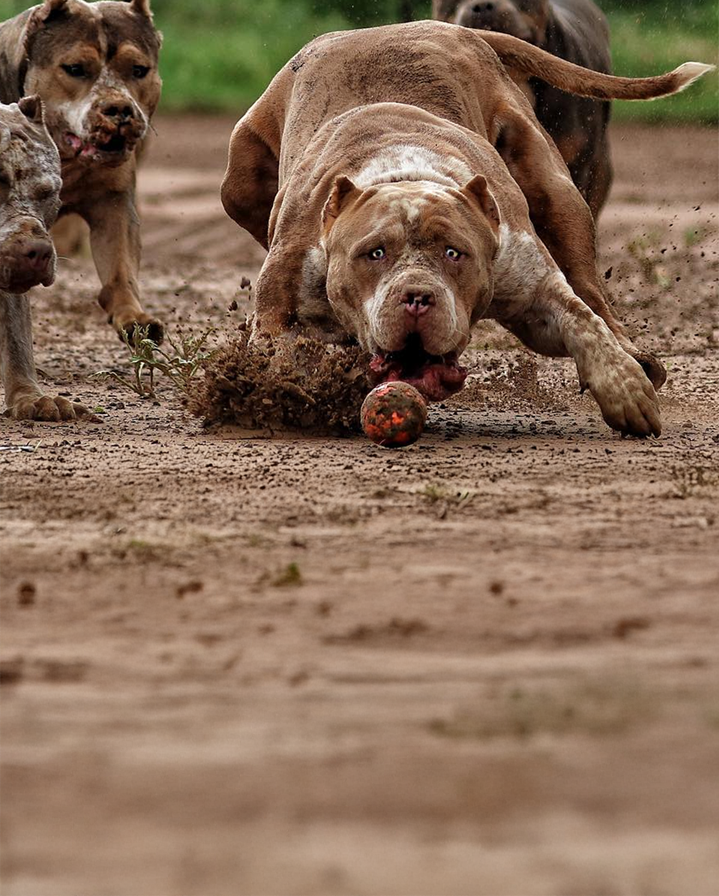Are Staffordshire Bull Terriers and American Bullies the Same?
Though easily confused, the Staffordshire Bull Terrier, frequently known as a Staffy, and the American Bully are two distinct breeds of dogs. Both of these large, muscular working dogs share a similar powerful look. Though these large, muscular, broad-headed dogs have many similarities, they are distinct breeds.
Breed Origins and History
The Staffordshire Bull Terrier is an old and established breed that dates back to the early 1800s. The early dogs of the breed were mastiff-like dogs that were first crossed with British terriers to produce a large, muscular dog with a strong prey drive and the agility of terriers. The Staffordshire Bull Terrier was first used in 19th-century England as a participant in blood sports, including bear and bull baiting, and then dog fighting. These sports eventually fell out of favor and were ultimately outlawed. When Staffordshire Bull Terriers were no longer utilized as bull-baiting dogs, they were transitioned into companion dogs and became popular as family pets.
The Staffordshire Bull Terrier is a relatively old breed dating back to 19th-century England, the American Bully is a new breed developed in the United States in the 1990s. The American Bully breed was developed by breeding American Pit Bull Terriers, Staffordshire Bull Terriers, as well as other bully-type breeds. The goal in creating this breed was in large part to maintain the physical characteristics of the dogs, but to soften the temperament into a dog easier suited to being a companion. The American Bully was first developed as an active and strong companion dog, making a good temperament a key priority for the breed. The American Bully is generally a larger breed of dog than the medium-sized Staffie. The American Bully comes in multiple sizes (pocket, standard/classic, and XL Bully). The XL and standard sizes are generally larger in size than the Staffordshire Bull Terrier, but all sizes have more pronounced muscles and a wider head than the Staffordshire Bull Terrier.
Because it is a long-established breed, the Staffordshire Bull Terrier is recognized by a variety of kennel clubs, including the United Kennel Club (UKC) and the American Kennel Club (AKC). Currently, the American Bully is recognized by the United Kennel Club (UKC) but is not recognized by the American Kennel Club. This means that American Bullies cannot participate in AKC Conformation, and to compete in AKC sports like Agility, Rally, Fast CAT, and Obedience, they must be altered (spayed/neutered).
Physical Characteristics of Staffys & American Bullies
Staffordshire Bull Terriers are muscular, medium-sized dogs weighing between 24 and 38 pounds. They have a broad head, a wide jaw, and a short muzzle. These broad-headed, muscular dogs have a short coat and have a powerful and athletic build. American Bullies range in size from the Pocket variety, which are compact and small to the common standard variety, mostly closely size-wise similar to the Staffordshire Bull Terrier and the XL Bully. American Bullies, regardless of which of the three sizes, have a heavy bone structure, broad heads, and pronounced muscles. American Bullies at their largest can be up to 150 pounds. Both American Bullies and Staffordshire Bull Terriers have short coats and come in a wide variety of colors, including black, brindle, fawn, and red.

Grooming & Exercise:
Both breeds of dog have similar needs as far as exercise, care, and grooming. Because of their short coat, neither breed requires extensive regular grooming; however, regular brushing with a curry-comb type brush should be used to stimulate the skin and remove dead fur. For overall skin and fur health, regular baths are also important for both breeds as well as regular tooth brushing, ear cleaning, and nail trims. Both American Bullies and Staffordshire Bull Terriers are active and athletic dogs. Both breeds need regular daily exercise that provides both mental and physical stimulation and enrichment. Making sure these active dogs get enough exercise can make them happier companions and help prevent nuisance and boredom-related behaviors, including excessive barking, digging, and chewing.
Temperament and Behavior:
Because they are closely related, amongst well-bred and well-socialized dogs, there are a lot of similarities in behavior and temperament for the Staffordshire Bull Terrier and the American Bully. While today the primary job of both the American Bully and the Staffordshire Bull Terrier is to be a companion pet dog, it is important to note that some dogs will still have the personality and behavioral characteristics of the earlier breeds. This can lead to a predisposition to dog selectiveness or dog aggression. This can be a challenging behavior in modern society, where we expect our dogs to exist socially in the world. Because of this hereditary predisposition, it’s important to focus on socialization with young puppies to help them develop positive associations with being around dogs and people.
Both breeds are known for their loyalty and affection for their families, though American Bullies in particular are also known for being more friendly and calm in temperament. These characteristics will however be different from dog to dog, and are heavily dependent on their genetic background of the particular dog, the parents’ temperament, and the kind of socialization they received as young puppies. Both American Bullies and Staffordshire Bull Terriers are large and powerful breeds of dogs that require training and socialization to make sure they are well-behaved companions. Both Staffy’s and the American Bully make wonderful companion dogs if trained, socialized and properly managed. Unfortunately, there exists a significant misunderstanding and stereotypes about the breeds. Both are frequently labeled as being aggressive, regardless of an individual dog’s behavior and temperament.
Although the Staffy and the American Bully have a shared ancestry, and there are a variety of behavioral and physical similarities between the dogs, they are distinct and different breeds. Because of the similarities between the breeds, they are often confused and misidentified as being the same. Because of their similarities, both breeds are frequently subject to discriminatory policies and are targeted by breed-specific legislation (BSL), and restrictions on owning breeds wrongly labeled as aggressive. If you are considering adding a Staffy or an American Bully to your family, make sure to do your research about which dog is going to be right for your lifestyle.
If you've had experiences with American Bullies or Staffys, share your insights in the comments below. How have you helped educate others about these breeds and their characteristics?









